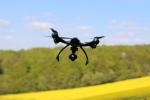H2020 VetBioNet Project: Network of biocontained veterinary facilities for excellence in research and experimentation in animal infectious diseases
- Type Project
- Status Filled
- Execution 2017 -2023
- Assigned Budget 9.999.140,5 €
- Scope Europeo
- Main source of financing Horizon 2020
- Project website Proyecto VetBioNet
A total of 75 TNA applications (12 in the fourth reporting period) have been received and processed by the TNA Access Point (TNAAP). 51 projects (11 in the fourth reporting period) have been approved following review by the User Selection Panel (USP). The TNA users came from 20 different countries (10 EU Member States and 10 associated/third or international countries). The Veterinary Emerging Threats Response Group (VETRG) has been established as a consultative group to deliberate on project means to respond to imminent and/or predictable threats from emerging infectious diseases. An internal call for projects related to African swine fever (ASF) or zoonotic flavivirus infections was launched in November 2019 using a €240,000 Emergency Fund (EF) intended for urgent and/or priority research responses. Three PPA-related projects have been selected for FE support and were successfully completed in the fourth reporting period.
The use of a VetBioNet area on the International Veterinary Biosecurity Working Group (IVBW) website enabled the wide dissemination of the project's results on best practices in high-containment animal facilities, including high-containment farm animal facilities (HCFAFs) and aquatic animal facilities. Eight best practice guideline documents were published on the VetBioNet website.
The project's activities, which addressed the ethical and social dimensions of VetBioNet's research work, resulted in the production of six public reports or guideline documents, as well as various online resources and tools related to the 3Rs (Replacement, Reduction, and Refinement). The VetBioNet website received over 200,000 visitors and over 2,500,000 clicks. Two short videos introducing VetBioNet topics, available on YouTube, generated a total of over 1,000 calls. Three webinars were live-streamed and posted on the VetBioNet website. Three training events were organized during the fourth reporting period, and five in total. A database has been created to share data generated by the project (including internal/confidential and public data entries).
VetBioNet's sustainability is achieved, at least in part, through the network's participation in the ISIDORe consortium. The VetBioNet Sustainability Committee has initiated the process for the creation of a VetBioNet European Research Group (ERG), and a draft ERG agreement has been distributed among network partners. Several livestock models have been developed for infection studies with highly pathogenic animal viruses. Reservoir host models have been developed for infection studies with Middle East respiratory syndrome coronavirus (MERS-CoV), influenza A virus (IAV), and Rift Valley fever virus. Animal models have been developed for airborne infection studies with SARS-CoV-2 and IAV. Fish models have been developed for infection studies with various viral pathogens. Numerous alternative infection models based on immortalized primary cells, organoids, viable tissue explants, and embryonated chicken eggs have been developed. Transcriptomics and deep sequencing approaches have been developed to analyze the host response of livestock (pigs, cattle, poultry) to pathogen infection or the plasticity of viral infection within the infected host.
Diagnostic assays have been developed to help accelerate the detection of pathogens and infections in rabbits, salmonids, and ruminants. New telemetry tools and protocols have been developed to monitor physiological parameters and behavior in livestock, fish, and laboratory animals.
VetBioNet is a six-year infrastructure project (2017-2023) bringing together 28 European and international partners from 12 different countries. VetBioNet's overall objective is to establish and maintain a comprehensive network of preeminent high-containment facilities, public or academic research organizations, and industry partners dedicated to advancing research on epizootic and zoonotic diseases.
To achieve this overall objective, VetBioNet specifically aims to: provide free access to the network's infrastructure resources, including biocontained animal facilities or laboratories, technology platforms, and sample collections; enhance the preparedness of key European high-containment research infrastructures to accelerate the response to (re)emerging threats from epizootic and zoonotic diseases; harmonize best practices and promote the use of global standards in high-containment animal facilities; forge cooperative relationships with non-European high-containment infrastructures, research networks, industry, international organizations, and policymakers; ensure high ethical standards and clarify the societal impact of VetBioNet's research work; and conduct research activities designed to improve the scientific and technological standards of the services provided by the network.
Despite the obvious impact of the COVID-19 pandemic on project performance in 2020/21 (which required a 12-month extension), the VetBioNet project successfully achieved its overall objective and delivered all 101 deliverables. The network is now recognized as a key player in the European research and preparedness response to (re)emerging infectious disease outbreaks and is one of 17 research infrastructures or networks participating in the ISIDORe (Integrated Services for Infectious Disease Outbreak Investigation) infrastructure project (Horizon Europe, 2022–2025).
VetBioNet seeks to complement and strengthen existing European capacity and expertise to address the challenges of (re)emerging infectious diseases by establishing a comprehensive network of European Basic Security Level 3 (BSL3) infrastructures, international organizations, and leading industrial partners, dedicated to advancing research on epizootic and zoonotic diseases and promoting technological development. To achieve this overall objective, VetBioNet will:
- It will promote and facilitate Transnational Access (TNA) to the network's infrastructure resources, including BSL3 animal testing facilities and laboratories, technology platforms, and sample collections.
- It will promote technological development by involving private partners in the network's Integration Activity and providing a communication platform for two-way exchange with industry stakeholders.
- It will enhance the readiness of key European BSL3 research infrastructures to accelerate the response to (re)emerging epizootic and zoonotic threats by sharing capabilities beyond the infrastructures.
- It will harmonize good practices and promote the use of global standards in European BSL3 infrastructures.
- Forge cooperative relationships with non-European BSL3 infrastructures, research institutes, industrial partners, international organizations, and policymakers.
- Ensure high ethical standards and clarify the social impact of VetBioNet research.
- Develop and implement a Sustainability Plan to ensure the network continues beyond the five-year funding deadline.
- Carry out Joint Research Activities (JRAs) designed to improve the scientific and technological standards of the integrated services provided by the network's infrastructure. The establishment of this network and the implementation of the proposed work program will contribute to improving the efficiency of European research on emerging epizootic and zoonotic diseases, which in turn will lead to the development of appropriate and robust prevention and control measures.
A network is streamlining work on the prevention and control of animal diseases linked to high-risk pathogens by opening access to highly sought-after facilities, tools, and services. The current pandemic has confirmed what scientists have long known. Accelerating the pace of research and knowledge acquisition on high-risk pathogens (highly infectious, highly pathogenic, or both) is critical to our safety. Uncontrolled outbreaks of infectious diseases have a global impact on lives, livelihoods, economies, and health systems. Understanding how these pathogens function is crucial for preventing and containing the spread of disease. However, precisely because of their high risk, these pathogens must be studied in specialized high-containment facilities, of which few exist worldwide.
The EU-funded VetBioNet project has established a multidisciplinary network to strengthen cooperation between leading European high-containment animal facilities, improve technical capabilities and services, and provide free access. Unparalleled high-containment animal facilities VetBioNet has brought together most of the European research organizations with high-containment animal facilities, as well as four partners in Africa, North America, and Australia, to conduct research on infectious diseases in terrestrial and aquatic animals.
The network features some of the most expensive and technically complex facilities, those used for infection experiments on large animals (livestock). “These high-containment facilities for farm animals are rare—there are probably no more than a few dozen worldwide—and their availability to transnational users is a unique feature of the VetBioNet project,” notes Sascha Trapp of the French National Research Institute for Agriculture, Food and Environment (INRAE) and VetBioNet coordinator. New tools and research on zoonotic and epizootic diseases VetBioNet research covers important animal diseases that cannot be transmitted to humans, such as African swine fever, and those that can (zoonotic diseases), such as COVID-19 and avian influenza, including epizootic diseases (outbreaks of epidemic diseases in animal populations). The consortium's joint research activities have generated numerous disease models, protocols, and monitoring technologies to accelerate our understanding of these diseases. These numerous animal and alternative models include the first model for airborne SARS-CoV-2 infections in ferrets. New genetic tools and protocols to increase our understanding of infection and immunity in livestock leverage transcriptomics, high-throughput genotyping, and next-generation sequencing protocols.
The sensor technologies or protocols will enable the monitoring of physiological parameters and behavior in livestock, laboratory animals, and fish to improve ethical and technological standards in animal research and support prevention and treatment. The facilities have been in high demand from external users. As of June 2022, they had 51 transnationally accessible user projects representing 21 different countries (including 6 non-European ones) and a mix of universities, public research entities, and SMEs. From SARS-CoV-2 today to epidemic infectious diseases of tomorrow, VetBioNet has played a pivotal role in the fight against COVID-19. Marie-Isabelle Thoulouze, INRAE, Deputy Coordinator of VetBioNet, explains: “Several VetBioNet partners were studying zoonotic coronaviruses as part of their activities before the pandemic.
They responded quickly and effectively, gaining valuable insights into animal susceptibility and risks to humans.” Trapp adds that “laboratory animal models for SARS-CoV-2 infection studies, including preclinical efficacy studies, are currently available at all VetBioNet High Containment Animal Facilities.” The VetBioNet consortium operates at the forefront of Europe’s research response to zoonotic and epizootic disease threats. The network is now one of 17 Life Sciences Research Infrastructures in the ISIDORe project, the largest and most diverse research and service delivery tool for the study of infectious diseases in Europe. VetBioNet will support ISIDORe in enhancing Europe’s capacity to control (re)emerging and epidemic infectious diseases.
The TNA provided by the VetBioNet project consisted of free access to the network's scarce and highly sought-after infrastructure resources. The TNA project call was organized as a standing call (from January 2018 to September 2022) and has led to the successful implementation of 51 user projects, including three projects with private-sector users. Joint Research Activities (JRAs) conducted by partners aimed to improve the scientific and technical standards of the services offered by VetBioNet. JRAs have led to the development of new live or alternative animal models for various high-impact epizootic and zoonotic diseases. Other JRAs have contributed to the advancement of current analytical, telemetry, or bioimaging approaches in animal infectious disease research. Five private partners were directly involved in VetBioNet JRAs, enabling technological development with an advanced level of technological maturity and the potential commercialization of some project results.
The overall objective of the project's Network Activities (NAs) was to foster cooperation among consortium partners and forge cooperative relationships with other European or international research initiatives, industrial actors, international organizations, and policymakers. A Preparedness Plan has been implemented to establish VetBioNet as a major player in the European emergency response to infectious disease outbreaks. VetBioNet NAs, which address best practices and the harmonization of protocols and procedures, have contributed to the advancement of biosafety standards in high-containment research facilities and could inform future EU guidelines or regulations. NAs questioning the ethical and social dimensions of VetBioNet research activities have led to several public reports and represent a social science approach that is arguably unique among European life science infrastructure projects within the One Health framework.
- INSTITUT NATIONAL DE RECHERCHE POUR L'AGRICULTURE, L'ALIMENTATION ET L'ENVIRONNEMENT (INRAE)







